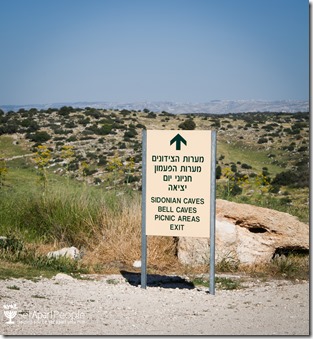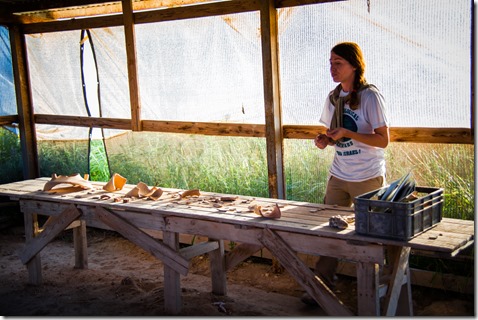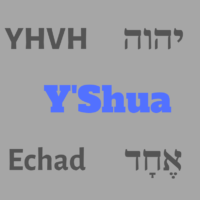Whenever we travel to Israel for one of the feasts, we always look for something of interest to do. Traveling with our kids also means that we have to look for something that would interest them. However, in a country as rich in culture and history, it is not a difficult task. On one of these trips, we decided to give our kids a better understanding of what archeology is and what value it adds. After some searching, we found the ideal solution. We could join a group of professional archeologists who are busy excavating a site near Jerusalem. We would all join them in a physical dig! What more would a child want? Real treasure hunting while playing in the dirt! We ended up with a very pleasant and enlightening day that I am sure all the kids would remember.  Let me share some of this with you.
Archaeological Seminars Institute presents a half-day tour to Tel Maresha, in the area of Beit Guvrin, called “Dig for a day.â€Â During this tour, they provided us with a basic background of the site, including the history of Maresha, and what the current excavation entails. The site is part of the National Park of Beit Guvrin, allowing you to make a full-day trip out of it. It is within an hour’s drive from Jerusalem making it a good day trip from Jerusalem. Let me share some historical background in order for all to understand the context of the dig. Then I will share our experience with you.
Historical Information
Biblical References
The first time we find a reference to Maresha, is in the book of Joshua. Here the town is listed as one of the towns that was allocated to the tribe of Judah.
Joshua 15:42–44
42 Libnah and Ether and Ashan, 43 and Iphtah and Ashnah and Nezib, 44 and Keilah and Achzib and Mareshah; nine cities with their villages.
In the book of 1 Chronicles we find two references ( 1 Chron 2:42 and 1Chron 4:42) to Mareshah. However, in this case, it is not certain if the reference is to a place or a person. All of these verses relayte back to the tribe of Judah. The next reference we find pointing to the city is after the split of the kingdom of Solomon. We find that king Rehoboam, the son of Solomon and Naamah, had these cities fortified.
2 Chronicles 11:5–10
5 Rehoboam lived in Jerusalem and built cities for defense in Judah. 6 Thus he built Bethlehem, Etam, Tekoa, 7 Beth-zur, Soco, Adullam, 8 Gath, Mareshah, Ziph, 9 Adoraim, Lachish, Azekah, 10 Zorah, Aijalon and Hebron, which are fortified cities in Judah and in Benjamin.
Later in the book of Chronicles we read of the miraculous battle that was fought at Mareshah. King Zerah of Ethopia came against King Asa, son of Abijah. King Asa was one of the few righteous kings who had sought YHVH and tried to cleanse His land. This was a massive army that came to conquer the land. The Ethiopians came with an enormous army of 1 million soldiers and 300 chariots to conquer the land. Kind Asa took his army of 580,000 men to the valley of Zephathah at Mareshah and prepared for the battle. After King Asa had called on YHVH to help them, YHVH provided the miracle required for a small army to defeat this massive army from Ethopia.
2 Chronicles 14:9–12
9 Now Zerah the Ethiopian came out against them with an army of a million men and 300 chariots, and he came to Mareshah. 10 So Asa went out to meet him, and they drew up in battle formation in the valley of Zephathah at Mareshah. 11 Then Asa called to YHVH his Elohim and said, “YHVH, there is no one besides You to help in the battle between the powerful and those who have no strength; so help us, O YHVH our Elohim, for we trust in You, and in Your name have come against this multitude. O YHVH, You are our Elohim; let not man prevail against You.†12 So YHVH routed the Ethiopians before Asa and before Judah, and the Ethiopians fled.
The prophet Eliezer is also born in Mareshah. Elizier is the prophet whom YHVH had used to speak to King Jehoshat, king of Judah, after he had made an alliance with King Ahaziah of Israel.
2 Chronicles 20:35–37
35 After this Jehoshaphat king of Judah allied himself with Ahaziah king of Israel. He acted wickedly in so doing. 36 So he allied himself with him to make ships to go to Tarshish, and they made the ships in Ezion-geber. 37 Then Eliezer the son of Dodavahu of Mareshah prophesied against Jehoshaphat saying, “Because you have allied yourself with Ahaziah, YHVH has destroyed your works.†So the ships were broken and could not go to Tarshish.
During the reign of King Hezekiah, the southern cities of Judah were invaded by the Assyrian King Sennacherib. This was earlier prophesied by Micah.
Micah 1:14–16
14 Therefore you will give parting gifts On behalf of Moresheth-gath; The houses of Achzib will become a deception To the kings of Israel. 15 Moreover, I will bring on you The one who takes possession, O inhabitant of Mareshah. The glory of Israel will enter Adullam. 16 Make yourself bald and cut off your hair, Because of the children of your delight; Extend your baldness like the eagle, For they will go from you into exile.
Although we do not see a specific mention of the city, we can assume that it was part of the cities that were conquered by Sennacherib.
2 Kings 18:13
13 Now in the fourteenth year of King Hezekiah, Sennacherib king of Assyria came up against all the fortified cities of Judah and seized them.
King Sennacherib was not able to destroy the city of Jerusalem as YHVH had protected the city. This was promised to King Hezekiah by the prophet Izaiah. YHVH sent an angel in the night that struck down 185,000 Assyrian soldiers. King Sennacherib returned to Nineveh where he died soon afterwards.
2 Kings 19:20
20 Then Isaiah the son of Amoz sent to Hezekiah saying, “Thus says YHVH, the Elohim of Israel, ‘Because you have prayed to Me about Sennacherib king of Assyria, I have heard you.’
2 Kings 19:35–36
35 Then it happened that night that the angel of YHVH went out and struck 185,000 in the camp of the Assyrians; and when men rose early in the morning, behold, all of them were dead. 36 So Sennacherib king of Assyria departed and returned home, and lived at Nineveh.
Inter-testamental period
After the Babylonian invasion by Nebuchadneser, the city became under the influence of Edom. The city became a part of the Sidonian province. During the reign of Xerxes, Sidon became the first in rank of the vassals. Sidon remained a key city of the Persian empire until it was conquered by Alexander the great in 332 B.C. From the record of the period, the papyri of Zenon, we learn that there was a large colony of Sidonians in Maneshah around 260 B.C., and that it was a key city in the slave trade with Egypt.
During the time of Alexander the Great, a large Greek community (6,000 – 10,000) settles in Mareshah. They fortify the upper city and later build a wall around the lower part of the city. With the death of Alexander, Judea is trapped between the battles of the Seleucids and the reign Ptolemy. The Ptolomies, who rule of Egypt, has control over the city, and it becomes a supplier of olive oil to the Egyptian based kingdom. During excavations at the site, the remains of an olive oil “factory†was found at the site. Around 20 olive presses have already been found at the site. Residents squeezed approximately 300 metric tons of olive oil a year.4 Later, the power struggle changes and Mareshah come under Seleucid rule. During the time of the Selucids, the southern parts of Judea come under the control of the Edomites, now called the Idumeans. This also stopped the export of olive oil to Egypt!
After the actions of Antiochus Epihanes, we have the start of the Maccabean revolt. This period is described in the books of the Maccabees. It is during this time that we pick up the history of Marisa. We find additional information regarding the town in the book of the Maccabees. Here we see the battle that Judah Maccabee, son of Mattathias, had with the Edomites and the success that they had. After this success around Hebron, they turn their attention to the Philistines (Azotus was the Philistine name for Ashdod) and have to march through Marisa.
1 Maccabees 5:65–68
65 Then Judas and his brothers went out and fought the descendants of Esau in the land to the south. He struck Hebron and its villages and tore down its strongholds and burned its towers on all sides. 66 Then he marched off to go into the land of the Philistines, and passed through Marisa. 67 On that day some priests, who wished to do a brave deed, fell in battle, for they went out to battle unwisely. 68 But Judas turned aside to Azotus in the land of the Philistines; he tore down their altars, and the carved images of their gods he burned with fire; he plundered the towns and returned to the land of Judah.
These battles for Hebron, Mareshah and Ashdod were also recorder by Josephus Flavius in his Antiquities of the Jews.
(353) But Judas and his brethren did not leave off fighting with the Idumeans, but pressed upon them on all sides, and took from them the city of Hebron, and demolished all its fortifications, and set all its towers on fire, and burnt the country of the foreigners, and the city Marissa. They came also to Ashdod, and took it, and laid it waste, and took away a great deal of the spoils and prey that were in it, and returned to Judea. – Antiquities 12.352–3531
After the Maccabees had rid themselves of the oppression of the Seleucids, John Hyrcanus I became the Hasmonian king and High Priest. He was the son of Simon Maccabeus and the grandson of Mattathias. When he became the king, around 135/4 B.C. and decided that he needed to cleanse the land of the worship of false gods. When he heard of the death of Antiochus, he started his quest with the destruction of the temple of the Samarians and the conquest of the land of the Idumeans. When he attacked the cities of Idumea, he gave them three choices, leave, die or convert to Judaism. Those that chose to stay, were forcibly converted via circumcision. We have this also recorded by Josephus. The destruction of Mareshah by Hyrcanus happened around 113 B.C.
During an internal power struggle between Hyrcanus II and Antigonus II, Antigonus II calls on the help of march Anthony. When this does not succeed, he flees to Parthia and makes a league with the king of Parthia. The Parthians agree to assist Hyrcanus II to depose AntigonusII and invade Judea. In 40 B.C. the city of Mareshah was destroyed by the Partians as a part of this power struggle between the two Hasmonean brothers2. The city was never rebuilt.
Modern Period
Mareshah is today connected with the site of Tel Sandahannah (Arabic name), located around 2km south of Beth Guvrin. Less than a mile south of Tel Sandahannah is Khirbet Mar‘ash (the ruin of Mar‘ash). The site was first associated with the Biblical town of Mareshah, by Edward Robinson (American professor of Biblical literature; 1794-1863) during his travels of Israel (1871 – 1877). The site was explored by Sir W.M.F. Petrie and F.J. Bliss from 1890 to 1892. The site was excavated by the Palestine Exploration fund in 1900 by F. J. Bliss and R. A. S. Macalister in 1900, as part of a series of excavations in the Shephelah.3 Finally, in 1902, when the New York archaeologist Rev. John Peters and his German colleague Hermann Thiersch were shown an  impressive painted tomb and they found a Greek inscription above the tomb of one Apollophanes, son of Sesmaios, who is identified as “chief of the Sidonians at Marisa†(the Greek form of Maresha). This inscription conclusively pinned down Tell Sandahanna as Biblical Mareshah. 4
impressive painted tomb and they found a Greek inscription above the tomb of one Apollophanes, son of Sesmaios, who is identified as “chief of the Sidonians at Marisa†(the Greek form of Maresha). This inscription conclusively pinned down Tell Sandahanna as Biblical Mareshah. 4
All the history that I had described above has been confirmed by what the archeologists have found on Tel Mareshah. Here is a short summary of what the site contained.
The Hellenistic city was almost square in plan (158 m E-W by 152 m N-S) and was surrounded by a wall defended with square and rectangular towers. The original plan of the city was organized according to the Hippodamian system, with 2 parallel main streets running E-W and 3 N-S streets intersecting the main streets at right angles. The streets varied from 2–6 m wide, most of which still had remains of paving. The street plan bounded 12 blocks of buildings, while the block located near the E wall was evidently the religious and administrative center. The three chambers in the center of the courtyard were used as a temple to honor a trinity of gods. A square structure with two courtyards, one a marketplace, the other a caravansary, also covered a city block.
…..
Among the finds of the Hellenistic period were hundreds of vessels, Rhodian handles, 3 Greek dedicatory inscriptions, 16 small lead figurines which apparently served magical purposes, 51 limestone tablets, and 61 coins (including 13 Ptolemaic, 19 Seleucid, 25 from the time of John Hyrcanus, 1 Herodian, and 2 Greek coins of unclear provenance). Recent excavations directed by A. Kloner have found hundreds of vessels, Rhodian handles, figurines, and coins from the lower city and its caves.
The finds from the upper excavated tell and the underground systems indicate that at least three Hellenistic strata existed at Tell Maresha:
 Ptolemaic (3d century B.C.E.); Seleucid (2d century B.C.E.); and Hasmonean (late 2d–early 1st B.C.E.).
Ptolemaic (3d century B.C.E.); Seleucid (2d century B.C.E.); and Hasmonean (late 2d–early 1st B.C.E.).Beneath the Hasmonean layer, at a depth of 3.05 m, was an Israelite (“Jewishâ€) stratum dated to the Iron Age 2C. The finds from this stratum include 17 lmlk seals—11 of the double-winged type and 6 of the four-winged type—from various cities: 3 from Hebron; 3 from mmÅ¡t; 6 from Socoh; 2 from Ziph; and 3 whose names are illegible. 3
Ancient Maresha occupied this mound and also had a lower city with a cave complex. It contained a necropolis of 15 tombs. These tombs contain paintings and Greek inscriptions. They are dated to be from around 200 – 100 B.C.
Below the city of Marseha is a large number of caves. The caves have been created by the inhabitants of Mareshah in their process of excavating limestone for building purposes. Here is a quick summary of this:
Geologically, the area around Maresha consists of an Eocene limestone formation: Beneath a harder surface crust, known locally as nari, is a soft chalk that can easily be worked. To dig the caves, a hole was first chipped through the nari crust, and then the soft chalk beneath was hewn away, creating a short “chimney†that was gradually widened as it deepened. In all, there are up to 2,000 caves in Maresha and the surrounding area. The shape and character of each cave depended on its function—storage room, olive oil factory, pigeon cote, water cistern or some other purpose. 4
The site is currently within the Bet Guvrin-Maresha National Park. The part of the site that has already been excavated has been turned into a tourist park. This park now contains:
- 3 Columbarium Caves: Caves used for the raising of doves
- olive-oil press and grape-vat
- complex cistern systems
- a system of about 30 interconnected caves, which visitors can traverse underground to understand how people made use of such spaces in antiquity
- Sidonian Burial Caves: A series of impressive burial caves from the Hellenistic period (third-second centuries BCE), featuring reconstructed wall paintings
- the Bell Caves: A series of 80 large caves, which the ancient inhabitants connected by passageways
- the Roman Amphitheater
Dig for a Day
The site at Tel Maresha is currently being used by the Archaeological Seminars Institute (ASI) in their tour called “Dig for a Dayâ€. This allows a person with no training in archeology to participate in an excavation of a real historical site. The history of the  site is what allows for it to be used in such a way. During the quest by John Hyrcanus, the inhabitants of Maresha was given a choice of converting to Judaism or leaving. The people of Maresha decided to leave, but wanted to ensure that they leave nothing behind that could be of benefit to their assailants. Thus, it is believed, that they simply dumped all their trash into these caves that they had made and burnt or destroyed their own houses. The result is a number of caves, filled to the brim with the remains of a community that existed around 200 B.C. since all this content was dumped into the caves at the same time, means that there exists no “strata†in these caves.5
site is what allows for it to be used in such a way. During the quest by John Hyrcanus, the inhabitants of Maresha was given a choice of converting to Judaism or leaving. The people of Maresha decided to leave, but wanted to ensure that they leave nothing behind that could be of benefit to their assailants. Thus, it is believed, that they simply dumped all their trash into these caves that they had made and burnt or destroyed their own houses. The result is a number of caves, filled to the brim with the remains of a community that existed around 200 B.C. since all this content was dumped into the caves at the same time, means that there exists no “strata†in these caves.5
During one of our trips to Israel we decided to join them for a day. This was done with the specific intent of giving our children a bit  of a hands-on activity during the vacation. We were joined by two other families, and the group consisted of a number of adults and kids. We reserved our space on one of the tours via their website (highly recommended during the feasts, as they get really busy!) and enjoyed an afternoon exploring the history.
of a hands-on activity during the vacation. We were joined by two other families, and the group consisted of a number of adults and kids. We reserved our space on one of the tours via their website (highly recommended during the feasts, as they get really busy!) and enjoyed an afternoon exploring the history.
When we arrived at the site, we were met by one of the archeologists who works for ASI. She provided us with a quick introduction to the history of the site and explained to us what we would be doing for the afternoon. She explained the how the mount (tel) was created by one city being built on top of another. The habit of simply flattening a city and then building on top of the ruins, is what allows archeologists to see the history and development of a site over time. It is also the reason what many of these walled cities were raised so high above their natural environment.
Next we were taken to one of the caves that is currently being excavated. At the cave entrance, we were given more specific details of what were to do once inside the cave. As these are not tourist quality sites, the climb into the cave was a bit more tricky than normal, but still very manageable. Once inside the cave you really get a sense for how huge these caves are. They are several storeys high (some up to 10 meters) with a diameter of around 10 meters. At the bottom of the cave, we found our tools: l of picks, trowels and plastic buckets.
The next hour or so we spent digging in the dirt at the bottom of the cave. During the digging, people found many interesting things, including pieces of pottery, including household items like plates, bones of animals and even a metal nail. Although the metal nail is a fairly rare find, more was still to come. Near the entrances of the cave, a complete, 100% intact oil flask was found. This was typically used to store the pure oil that was used in the oil burning lamps. The people leading the group were very excited about these two items.
 After the exciting and fun bit, we had to help with some of the hard work as well. All the filled plastic buckets had to find their way to the top. Thus, we had to help carry these to the top. Once outside the cave we help to sift the content of the buckets to see if we missed anything. In our group, no additional major finds were made in the sifting process. In other groups, this sifting process had led to the discovery of metal jewelry like earrings.
After the exciting and fun bit, we had to help with some of the hard work as well. All the filled plastic buckets had to find their way to the top. Thus, we had to help carry these to the top. Once outside the cave we help to sift the content of the buckets to see if we missed anything. In our group, no additional major finds were made in the sifting process. In other groups, this sifting process had led to the discovery of metal jewelry like earrings.
Next we were given a taste of what it is like to go discovering a “newâ€cave. We were taken into another cave, where no excavation yet took place. The entrance to this cave was not yet cleaned a prepared for masses of people. Thus, we ended up crawling through small entrances, walking bent over and sometime knocking heads while exploring a dark cave that would later be excavated as well.
After all this is done, we were taken the a make-shift hall (the pottery shed), where we were given some additional information of things that have been found at the site. These included fascinating stories of how a set of ear rings were united. The most significant find at this site was three pieces that were missing from the base of the Heliodorus Stele. This indicates that this stele, that describes some of the happenings around the time of the original Chanukah (2 Maccabees 3:21-28), was most likely originally looted from this site. At the end of the presentation the children (and some adults) were allowed to pick for themselves some pieces of pottery, as a reminder of a wonderful experience.
Conclusion
If you plan to make a trip to Israel, and you want to get some fun and educative activities for the kids (young and old) this must definitely be on your list of things to do. Without doubt, this would be the closest you could get to antiquities without under going formal training in archeology. It also provided us with some additional information from a time in Israel’s history that very few people have knowledge of.
This tour has been done by more than one million people over the past 27 years. The funds raised by the fees paid for the tour has allowed the Archaeological Seminars Institute to pay for this excavation, including the costs of having the finds professionally processed.5
There is still a huge number of caves that have to be excavated, thus I believe that these tours will continue for a while. Do make an effort to put them on your list of things to do. If you are traveling to Israel during one of the feasts, do go to their website and book a spot for yourselves. They do tend to get quite busy during these times. If you are on Facebook, you can also go and look at their Facebook page to see what finds have recently been made.
References
- Josephus, F., & Whiston, W. (1987). The works of Josephus: complete and unabridged. Peabody: Hendrickson.
- Ironside, H. A. (1914). The four hundred silent years (from Malachi to Matthew) (67 – 70). New York: Loizeaux Brothers.
- Kloner, A. (1992). Mareshah (Place). (D. N. Freedman, Ed.)The Anchor Yale Bible Dictionary. New York: Doubleday.
- Shanks, H. (Ed.). (1997). Biblical Archeology Review 23:02 (March/April 1997) – Underground Metropolis: The Subterranean World of Maresha By Amos Kloner
- Shanks, H. (Ed.). (2013). Biblical Archeology Review 39:05 (September/October 2013) – A World Below: The Caves Of Maresha by Ian Stern









Leave a Reply